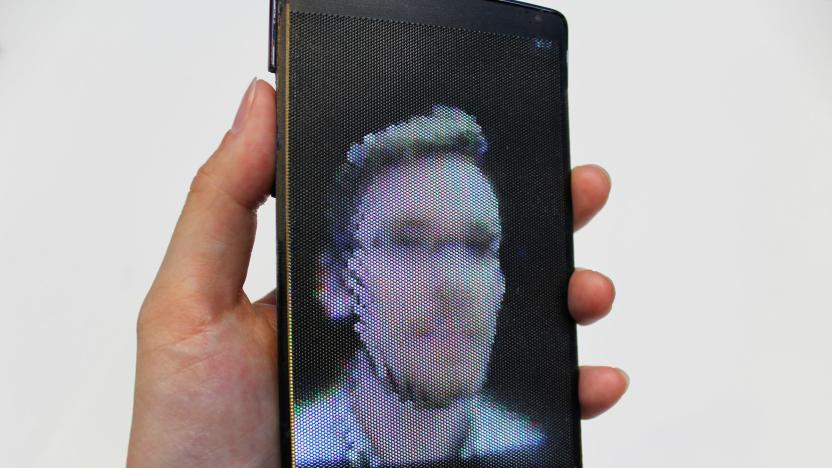queensuniversity
Latest

Your brain always has a backup plan
You may not always be consciously considering a Plan B when you're making a decision, but that doesn't mean it doesn't exist. Queen's University researchers have discovered that the human brain's motor neurons will prepare for multiple actions before making a decision. The team learned this by conducting experiments where volunteers were asked to guide a cursor toward one of two targets before they knew which one they were supposed to pick. While it was easy for the test subjects to consciously steer down the middle, the scientists took the cursor increasingly out of sync to make people compensate through unconscious actions. Sure enough, the volunteers' movements were an average of the movement paths needed to reach the targets, not the average between the positions -- their brains were already prepping for both paths.

The HoloFlex is a flexible, glasses-free 3D display
Researchers at the Queen's University Human Media Lab in Ontario have developed what they claim is the "world's first holographic flexible smartphone" display. Dubbed the HoloFlex, the display uses an array of tiny lenses overlaid onto one flexible 1,920 x 1,080 HD OLED screen and allows multiple people to simultaneously view 3D images without the need for clunky glasses, complex projectors or individual head tracking.

ICYMI: Feedback flex screen, cyborg Olympics and more
#fivemin-widget-blogsmith-image-580621{display:none;} .cke_show_borders #fivemin-widget-blogsmith-image-580621, #postcontentcontainer #fivemin-widget-blogsmith-image-580621{width:570px;display:block;} try{document.getElementById("fivemin-widget-blogsmith-image-580621").style.display="none";}catch(e){}Today on In Case You Missed It: Researchers built a prototype flexible display smart device with tactile feedback to actually use the bendable display for control within apps. Actev Motors has a new $600 go-cart for kids that has smart sensors that keeps it from crashing into things, and a parental control app that sets miles per hour limits. And to a person, we are so excited for the upcoming Zurich Cybathalon event next fall. In it, people with physical handicaps can compete in Olympic-like events designed for electric wheelchairs, exoskeleton suits and the like. We are also tickled by this video of a Star Wars droid translation helmet, so hopefully you enjoy it as well. As always, please share any interesting science or tech videos, anytime! Just tweet us with the #ICYMI hashtag to @mskerryd.

ICYMI: Record-setting bot walk, holographic drones and more
#fivemin-widget-blogsmith-image-309632{display:none;} .cke_show_borders #fivemin-widget-blogsmith-image-309632, #postcontentcontainer #fivemin-widget-blogsmith-image-309632{width:570px;display:block;} try{document.getElementById("fivemin-widget-blogsmith-image-309632").style.display="none";}catch(e){}Today on In Case You Missed It: Researchers from Queens University built tiny quadcopters that can join to form a hologram display, hovering in mid-air. A Guinness World Record for furthest distance by a quadruped robot was set in China by a quirky cute robot we'd love to see more of. And we're into this Kickstarter project for a device that would turn any watch into a smartwatch with vibration for notifications, a heart rate monitor and control for music and photos.

Researchers turn a swarm of drones into a physical hologram
The augmented reality interface in Minority Report was futuristic, but what it lacked were objects that you could physically touch, according to researchers from Queens University. The problem is that the film's virtual interface floats in mid-air, and physical objects tend to be ground-bound. To get around that, the team developed a system called BitDrones, with flying nano-drones serving several functions. "PixelDrones" have a basic LED display to show information, "ShapeDrones" are cubic objects that form a physical 3D "display," and "DisplayDrones" contain a touchscreen interface. All of them, plus the human operator, are tracked with a 3D motion capture system.

'TeleHuman' uses Kinect for 3D holographic chat, bumps up options for contacting Obi-Wan (video)
Looks like virtual Tupac might have some company. With Kinect, you are the hologram. Besides logging in lots of quality time at a South Korean theme park, the Kinect is now doing double duty at the Human Media Lab of Queen's University in Canada thanks to a 3D holographic chat system called "TeleHuman." The setup basically creates a life-size rendering of its subject by using six Kinect sensors, a 3D projector and a cylindrical display. This allows the viewer to walk around the cylinder for a 360-degree view of the subject, giving new meaning to having someone's back during a chat. The director of the Human Media Lab says the TeleHuman could be available for $5,000 within five years. In the meantime, the tech is also being used by the research team to create a 3D anatomical model browser called the "BodiPod." The BodiPod can display various layers of the human body, which can be virtually peeled off as the viewer gets closer to the display. Check out all the 3D action for the TeleHuman and BodiPod in plain, old 2D by viewing the video after the break.

Flexible PaperPhone wants to get bent out of shape (video)
We love our smartphones (in part) because they're flexible, in the sense that they are mighty multitasking machines. Researchers from Queen's University in Ontario Canada, however, want flexible phones in a literal sense -- less five-tool player, and more master contortionist. Using a ductile e-ink display and elastic electronic underpinnings, they created a device called the PaperPhone that literally bends to its user's will. Curling the corners of the device isn't just for show, either, as folding the phone is how users navigate menus and make calls. We aren't completely sold on the idea of a bend-based UI, but we're definitely digging the lithe and lightweight phone form factor. Video of the new flexi-phone is after the break. Update: A second video showing the same 3.7-inch display in a wearable computer project dubbed, "snaplet," has been added after the break.

Humans wearing radios could form massive wireless networks of the future
Researchers at Queens University in Belfast, Northern Ireland, are studying how to create an infrastructure out of human beings interconnected by wearing sensors, gateways and radios, resulting in a "body-to-body" network. Because human beings are so easy to come by, the networks could potentially be massive as well as high in bandwidth. The team is now studying how human bodies and movement can affect radio signals, and the general operations of body area networks, which aren't new. Concurrent research is being done at Carnegie Mellon to study how thousands of sensors can communicate with each other effectively. Long term, actual functioning body-to-body wireless networks could render cellular base stations unnecessary in heavily populated areas. Of course, that's all well into the future, but hit up the source for more details.

Hexagonal interactive OLED gaming tiles likely to cost a bundle, would sure spice up our Wednesday nights
We've seen plenty of ways for board games to be revitalized with large touchscreens, but a new concept from the Human Media Lab at Queen's University in Ontario puts the screens and interactivity onto the gaming pieces themselves. The idea would be to use slim, networked touchscreen hexagonal tiles with edge-to-edge OLED displays. The proximity of the tiles to one another, along with gestures performed with the tiles, provides the interactivity, and the occasional branching touchscreen menu selection keeps play humming. Unfortunately, that enabling tech isn't all there yet (at least in university-affordable forms), but the video demo after the break is pretty convincing in its presentation of these ideas in a top-down-projection simulation. Certainly promising, but we're sure not expecting to see this sort of gaming priced within reach of your average Sorry! board anytime soon.

Oyster Wave Energy Converter puts climate change to good use
One of the Holy Grails of green power is hydroelectricity, and we've certainly seen our fair share of research in that department. The newest guy on the scene is called Oyster, a collaborative effort between Queen's University in Belfast and Aquamarine Power Limited that sees something called an Oscillating Wave Surge Converter placed offshore (in depths around 10-12 meters). When moved by waves, the device's double acting pistons push seawater ashore via high pressure flow lines, where it is converted to power using tried and true hydroelectric generators. Since the hydroelectric plant is located onshore, it is accessible for maintenance 24-7. According to the company, peak power should be around 300-600 kw, depending on the unit's configuration and location. The first prototype is to be deployed off the coast of Orkney this summer, where we'll see if it can transform high tides and abnormal weather patterns into juice for your Xbox. One more pic for you after the break.[Via Renewable Energy World]

Non-planar devices promise downloadable hardware, interactive soda cans
Scientists have been up to some wacky (and amazing) stuff in the world of flexible computers and organic user interfaces. Putting our standard concept of computers aside, researches at the Human Media Laboratory at Queen's University in Canada are developing what are called "non-planar" devices: computers that can change shape while using three-dimensional and touch-driven interfaces. The "tank top" user interface is a smart fabric based around two-handed, multi-finger touch sensing. Paired with flexible displays and computers that can change shape to achieve different computing outcomes, you have what they call the computer of the future: computers that can download (and turn into) new hardware, foldable paper computers, and interactive / disposable product designs, because, you know, the advertisers won't be able to wait to get their hands on the first interactive soda can.






